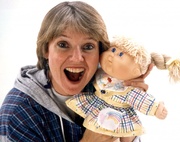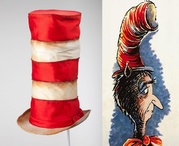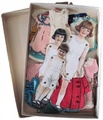
One of the most cherished myths about children is that they possess incredible imaginations. Put a child on the floor in front of a pile of blocks, this magical thinking goes, and she will assemble veritable Roman Aqueducts and Towers of Babel, making the efforts of most adults look, well, like child’s play.
“We had Eames furniture, of course. Who didn’t?”
In fact, psychologists have long known that the imaginations of children are actually kind of lame. That’s because most little kids are unfettered by the rules and conventions of life that the culture at large relentlessly pushes them to embrace. Adolescents are somewhat better in the imagination department because they have more life experiences to draw from, but the real kings and queens of make-believe are adults. Think about it: Children pretend broom handles are horses and throw tea parties for their dolls; adults sit down and write “Game of Thrones.”
All of which may help explain why, in 1951, it took the imaginations of two adults, Harry and Patricia Kislevitz, to come up with Colorforms, a toy whose only two elements are a handful of colorful die-cut vinyl shapes and a shiny play surface upon which those shapes can be placed and repositioned. That’s it—colored forms and something to put them on. Yet despite its simplicity, or probably because of it, more than a billion incarnations of Colorforms have been sold, whether it’s the basic-colored, geometric original, which has been re-released in special 50th and 60th anniversary editions, or the latest 3D Deluxe Playset featuring characters from the children’s TV show “Yo Gabba Gabba!”

Top: The original design for Colorforms is in the Museum of Modern Art and has been reissued by University Games in 50th and 60th anniversary editions. Above: Harry Zelenko, who created the first Colorforms logo, also did the design for this “Junior Dress Designer” Colorforms set with his graphic-designer wife, Marion.
Not surprisingly, given the toy’s limited universe of elements, its beginnings were humble. “Harry had just gotten out of the Navy and I had just graduated with a degree in art from the University of North Carolina,” recalls Patricia of her late former husband. “At the time, we were taking classes at the Art Students League in New York City. Harry loved to paint, but he couldn’t afford the price of materials on his G.I. Bill, so he called around and found a wonderful plastic material someone had been using to make pocketbooks. It would stick to any shiny surface, but that was the problem—all the pocketbooks stuck together. Harry asked me, ‘What do you think?’ and I said, ‘Let’s get some in primary colors.’”
Harry ordered a few rolls of red, yellow, and blue vinyl, which were delivered to the young couple’s apartment on 29th Street. “They were quite large,” Patricia recalls, “like maybe 3 1/2 feet tall and a foot and a half in diameter. We started cutting out pieces and sticking them on the refrigerator, mirrors, windows, anything that was shiny. Harry was the one who said, ‘I think we can make something out of this.’”
Having selected the initial colors, Patricia went on to create some forms. “I sat at the kitchen table and used a thimble for one circle, a bottle top for another. I just stuck to really basic shapes, which proved to be advantageous because it allowed kids to be very creative. The original design with the geometric forms is in the Museum of Modern Art,” she adds. “I still think it’s the most versatile.”

Graphic designer Paul Rand, who like Harry Kislevitz was a fan of painter Wassily Kandinsky, created the Colorforms logo in 1959 that’s still in use today. He also designed this set.
If the biggest myth about children concerns the depth of their imaginations, the biggest myth about Colorforms surrounds the reason for its adhering properties, which most people assume is the result of static electricity. “It’s really the absence of air,” says Moss Kardener of University Games, which has owned Colorforms since 1998. “The absence of air creates a vacuum, and the vacuum holds the piece in place. That’s also the reason we have a glass-like finish on the play boards, so there are no little craters to capture air, even on a micro level.”
“It wasn’t terribly appetizing. It didn’t have that ‘I’ve-got-to-eat-this’ quality.”
The first play boards (the surfaces the equally crater-less Colorforms shapes stick to) were nothing more than neutral rectangles, black on one side and white on the other, but that was good enough for New York City’s most respected toy retailer. “Our first order was from FAO Schwarz for 1,000 pieces,” says Kislevitz. “They wanted an exclusive, but Harry had the good sense to say, ‘I don’t think so.’”
Those first Colorforms were spiral bound as small booklets, each page being a different color for an array of different geometric shapes, of which there were 350 in all. Even though the art was simple, the outlines of the shapes still had to be silkscreened onto the colored sheets so they could be die-cut. “We silkscreened the whole thing in our apartment, one color at a time, and after we had our thousand, we had someone pick up everything to die-cut the shapes. He stacked the books and schlepped them off, and when he did, everything stuck together because the paint was not quite dry. But some burly dude took big handfuls of the books and cracked them over his knee. Most of them came apart, but you could still see little bits of paint in various places where they had stuck together. I wish I still had some of those now because they are just so representative of how hands-on we were in beginning.”

Colorforms licensed lots of cartoon characters, including Bugs Bunny and others from Warner Bros.
For the look of their new toy, the couple was strongly influenced by modern art and the Mid-Century Modern aesthetic of the day. “We had Eames furniture, of course,” says Patricia. “Who didn’t? And Harry was really into Kandinsky. We each did the artwork in the little booklets. He’d do one page, and I’d do another, and then we’d do the silkscreening, which took quite a while. We’d call in friends to help us punch out the pieces—for a while after that first order for FAO Schwarz, we did all the die-cutting ourselves.”
And then there was that smell, which may have had the unintended benefit, says Patricia, of keeping the small shapes out of the mouths of small children. “It wasn’t terribly appetizing,” she says. “It didn’t have that ‘I’ve-got-to-eat-this’ quality.”
“What’s always amazing to me,” adds Kardener, “is when I go to a cocktail party and mention that I work with Colorforms, the adults just melt in your hands. A lot of them say, ‘Oh, my God, that smell. I remember that smell!’ Some people I’ve spoken to have even suggested we try to capture whatever that smell was and synthetically put it back in the material. Of course, that smell was probably toxic.”

Yup, that’s Brooke Shields on the cover of this “Ballerina Barbie” box from 1977.
In 1957, the Kislevitzs did their first licensing deal for artwork they had not created or commissioned. It was with King Features Syndicate for the cartoon character Popeye. The first “Popeye Cartoon Kit,” as it was called, featured a couple of dozen blue, green, orange, and pink shapes of Popeye, Bluto, and Olive Oyl, as well as speech balloons filled with words like “Halp!” “GULP,” and “Oh! Popeye.” Subsequent Popeye Colorforms included “Popeye the Weatherman,” which was just one of numerous weather-themed Colorforms, from “Miss Weather” (still produced today) to “How’s the Weather, Lucy?” one of many “Peanuts” Colorforms. As a theme, weather worked well with Colorforms, since the child could busy herself with putting a slicker on a character if it was raining or a bathing suit when the sun was out.
In fact, licensing proved to be the key to the success of Colorforms, which, according to Kardener, has produced hundreds, if not thousands, of different licensed products, from The Beatles, Batman, and Barbie to Mickey Mouse, Michael Jackson, and the Muppets to Sesame Street, Smurfs, and Superman. Even today, University Games has some 75 active titles in its Colorforms line.

When the action-figures craze hit, Colorforms responded by licensing G.I. Joe. The top photo shows the empty play board, while the bottom one has been filled up with forms.
In one respect, all those young, impressionable minds were catnip to marketers, who wanted children to literally play with their brands. At the same time, as committed as the Kislevitzs were to unstructured creativity, they also wanted Colorforms to be a toy children could play with in a more social and less goal-oriented way. “In Europe,” Patricia says, “people say, ‘How can we make this toy educational?’ In the States, we say, ‘How can we make this toy fun?’ I think Colorforms did both.”
Today, despite being on top-100 lists and garnering 60-plus years of acclaim, Colorforms is just one of countless toys that are used like pacifiers to sedate the insatiable desires of children in the wealthy, developed world. “I think children have so many toys now that they don’t concentrate on the one or two that are important and wonderful,” says Patricia. “I can remember the three dolls that were important to me 80-something years ago, I can see them in my mind’s eye. I felt very much connected with their welfare. It’s wonderful to have something you love and have it mean a lot to you, but I don’t know if children have that experience anymore. Children today have so much stuff they’re distracted. Walk into the bedrooms of a lot of small children and the floor is literally covered with things.”
On the other hand, Kislevitz is not one for knee-jerk nostalgia. “Children have so much, they don’t even think about it, but maybe that’s a blessing. That bounty could be leading them to new inventions. My father, who lived to be 90-something years old, used to say, ‘More things have been invented during my lifetime than were invented from the beginning of time. I’ve seen lights and indoor plumbing and submarines and aeroplanes.’ He was one of the first men in South Carolina to own a Model T Ford. But he also used to say, ‘You think that was important? Wait for the next hundred years.’ So maybe all these children with all their things are part of that next hundred years.”
As for her children, five boys and one girl, “they were the kind of kids who loved finding a box on the curb that someone had gotten a washing machine in,” Patricia recalls. “They would drag it into the backyard, cut holes in it, and use it a playhouse. Our kids did play with Colorforms, and they painted with Harry on the rug and that kind of stuff. But my kids were like the shoemaker’s son who never had shoes. They had very few toys.”
(Images via the Strong Museum of Play and Dork Horde. Click here for more information on Colorforms.)




















 From Little Fanny to Fluffy Ruffles: The Scrappy History of Paper Dolls
From Little Fanny to Fluffy Ruffles: The Scrappy History of Paper Dolls
 Guys and Dolls: Veteran Toy Designer Wrestles With the Industry's Gender Divide
Guys and Dolls: Veteran Toy Designer Wrestles With the Industry's Gender Divide From Little Fanny to Fluffy Ruffles: The Scrappy History of Paper Dolls
From Little Fanny to Fluffy Ruffles: The Scrappy History of Paper Dolls Dr. Seuss, the Mad Hatter: A Peek Inside His Secret Closet
Dr. Seuss, the Mad Hatter: A Peek Inside His Secret Closet Paper DollsA paper doll is simply a flat drawing or print of a human or animal figure,…
Paper DollsA paper doll is simply a flat drawing or print of a human or animal figure,… Mid-Century ModernMid-Century Modern describes an era of style and design that began roughly …
Mid-Century ModernMid-Century Modern describes an era of style and design that began roughly … ToysToys are vehicles for the imagination, the physical objects children manipu…
ToysToys are vehicles for the imagination, the physical objects children manipu… Mari Tepper: Laying it on the Line
Mari Tepper: Laying it on the Line Nice Ice: Valerie Hammond on the Genteel Charm of Vintage Canadian Costume Jewelry
Nice Ice: Valerie Hammond on the Genteel Charm of Vintage Canadian Costume Jewelry How Jim Heimann Got Crazy for California Architecture
How Jim Heimann Got Crazy for California Architecture Modernist Man: Jock Peters May Be the Most Influential Architect You've Never Heard Of
Modernist Man: Jock Peters May Be the Most Influential Architect You've Never Heard Of Meet Cute: Were Kokeshi Dolls the Models for Hello Kitty, Pokemon, and Be@rbrick?
Meet Cute: Were Kokeshi Dolls the Models for Hello Kitty, Pokemon, and Be@rbrick? When the King of Comedy Posters Set His Surreal Sights on the World of Rock 'n' Roll
When the King of Comedy Posters Set His Surreal Sights on the World of Rock 'n' Roll How One Artist Makes New Art From Old Coloring Books and Found Photos
How One Artist Makes New Art From Old Coloring Books and Found Photos Say Cheese! How Bad Photography Has Changed Our Definition of Good Pictures
Say Cheese! How Bad Photography Has Changed Our Definition of Good Pictures Middle Earthenware: One Family's Quest to Reclaim Its Place in British Pottery History
Middle Earthenware: One Family's Quest to Reclaim Its Place in British Pottery History Fancy Fowl: How an Evil Sea Captain and a Beloved Queen Made the World Crave KFC
Fancy Fowl: How an Evil Sea Captain and a Beloved Queen Made the World Crave KFC
This is awesome !!!!!
I know absolutely for sure that there were Colorforms sets around the house when I was a kid, but I don’t remember what themes / licensed properties they had. We’re talking late ’60s.
I remember that when the shapes or boards got grubby, it was game over. They never stuck again.
Stefan, all you had to do was rinse them under the tap and they came back clean as anything (Maybe a little dish soap if really bad). And, like an iPad, a good rub with a damp cloth fixed the boards. In fact, they were fun wet, cuz they got slippery.
We had weather Lucy and a bunch of other licensed ones, as well as the shapes.
No matter how much I tried to always put the pieces back on the die-cuts, with six kids, you could usually find the boxes all jumbled up together at our house.
Does anyone remember when Colorforms made the infamous Outer Space Men. http://www.theouterspacemen.com
My parents loved these, because unlike most ‘art sets’ they could be reused endlessly. You could stick them on the TV, and play along with the show. It was my mission in life to get them perfectly lined up on their shape holders after play.
Loved these! As a a little kid (early 1970s) I had a classic movie monsters Colorforms set. Its base had two layers allowing doors to pop up.
I had HOURS of fun with the basic shapes set. Wish they were still around. So few toys allowing real creativity.
My twin sister and I received Colorforms Junior Dress Desigber Kit exactly like the one shown here for our 4th birthday. I have a photo of us holding them and wish I cohld post it here! I remember loving them.